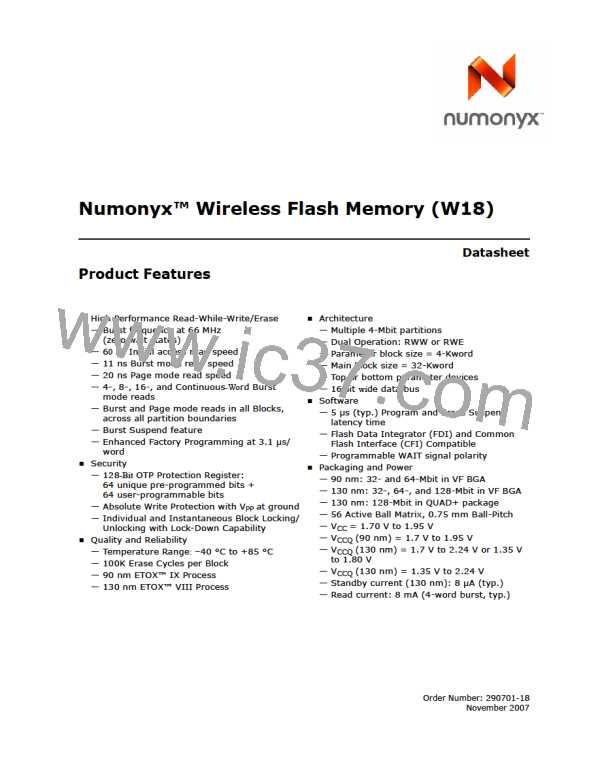Numonyx™ Wireless Flash Memory (W18)
Figure 39: Data Output Configuration with WAIT Signal Delay
CLK [C]
WAIT (CR.8 = 1)
Note 1
Note 1
tCHQV
WAIT (CR.8 = 0)
1 CLK
Data Hold
Valid
Output
Valid
Output
Valid
Output
DQ15-0 [Q]
WAIT (CR.8 = 0)
tCHTL/H
Note 1
Note 1
tCHQV
WAIT (CR.8 = 1)
2 CLK
Valid
Output
Valid
Output
DQ15-0 [Q]
Data Hold
Note: WAIT shown asserted high (RCR[10]=1).
14.6
WAIT Delay (RCR[8])
The WAIT configuration bit (RCR[8]) controls WAIT signal delay behavior for all
synchronous read-array modes. Its setting depends on the system and CPU
characteristics. The WAIT can be asserted either during, or one data cycle before, a
valid output.
In synchronous linear read array (no-wrap mode RCR[3]=1) of 4-, 8-, 16-, or
continuous-word burst mode, an output delay may occur when a burst sequence
crosses its first device-row boundary (16-word boundary). If the burst start address is
4-word boundary aligned, the delay does not occur. If the start address is misaligned to
a 4-word boundary, the delay occurs once per burst-mode read sequence. The WAIT
signal informs the system of this delay.
14.7
Burst Sequence (RCR[7])
The burst sequence specifies the synchronous-burst mode data order (see Table 35,
“Sequence and Burst Length” on page 84). When operating in a linear burst mode,
either 4-, 8-, or 16-word burst length with the burst wrap bit (RCR[3]) set, or in
continuous burst mode, the device may incur an output delay when the burst sequence
crosses the first 16-word boundary. (See Figure 37, “Word Boundary” on page 80 for
word boundary description.) This depends on the starting address. If the starting
address is aligned to a 4-word boundary, there is no delay. If the starting address is the
end of a 4-word boundary, the output delay is one clock cycle less than the First Access
Latency Count; this is the worst-case delay. The delay takes place only once, and only
if the burst sequence crosses a 16-word boundary. The WAIT pin informs the system of
this delay. For timing diagrams of WAIT functionality, see these figures:
• Figure 9, “Single Synchronous Read-Array Operation Waveform” on page 32
• Figure 10, “Synchronous 4-Word Burst Read Operation Waveform” on page 33
• Figure 11, “WAIT Functionality for EOWL (End-of-Word Line) Condition Waveform”
on page 34
November 2007
Order Number: 290701-18
Datasheet
83

 NUMONYX [ NUMONYX B.V ]
NUMONYX [ NUMONYX B.V ]